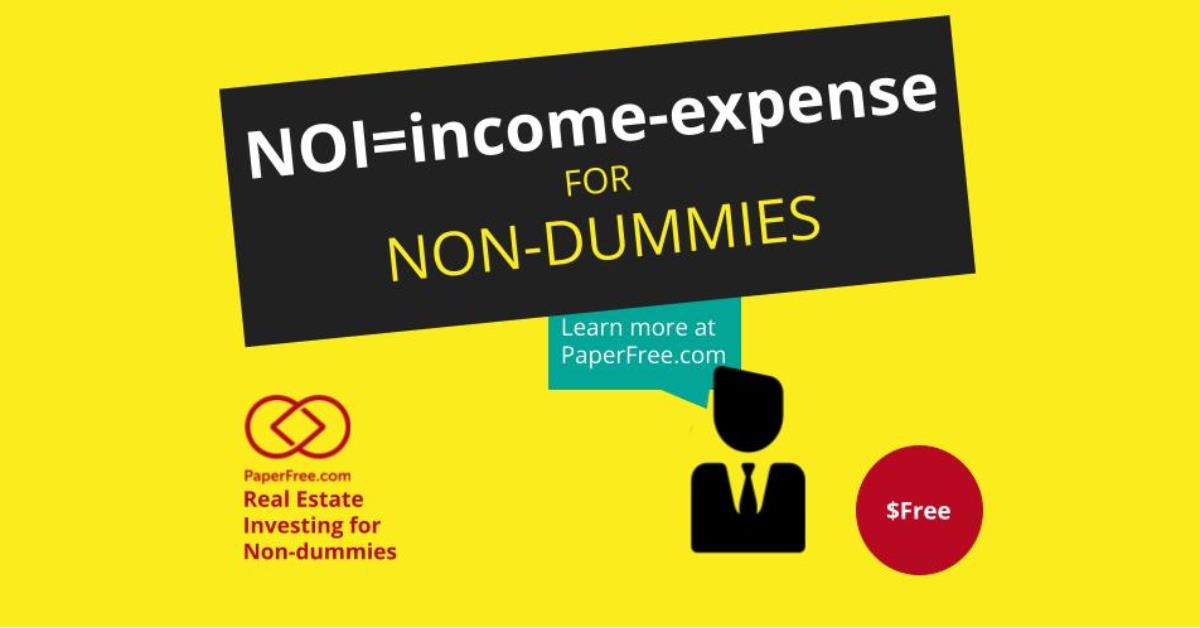The Net Operating Income for Real Estate Investors, beginners and advanced. How to calculate net operating income?
NOI definition, formula, how to use it . Example. How to calculate net operating income?last updated Friday, April 11, 2025
#net operating income #how to calculate net operating income
|
|
by John Burson by Sidra Jabeen |
Content Manager, Paperfree Magazine Content Manager, Paperfree Magazine |

QUICK LINKS
AD
Get Access to Real Estate Investment Opportunities
Net Operating Income Definition
The Net Operating Income (NOI) is a financial metric used by commercial real estate investors and lenders to calculate a specific investment opportunity's market value or cash flow during a particular period in the past or future.
How do real estate investors use NOI?
There are two main scenarios where NOI is used.
- Cash Flow Calculation.
The Net Operating Income (NOI) tool helps investors and lenders determine the cash flows generated by a property during a specific period. By analyzing the cash flows, they can assess the property's performance and decide whether it is a good investment or a lendable transaction. If you want to learn more about how to calculate cash flows, stay tuned for our upcoming articles. The NOI helps investors and lenders calculate the number of cash flows for a specific period from the property performance, assess the cash flows in a given property, and decide whether the property is a good performer or lendable. Learn more about cash flow calculation in our future articles. - Property Value Calculation.
The second NOI application. NOI is a tool that can be used to calculate property value. Then, the value can be used as a sales price, a metric in insurance quotation, or loan sizing. Learn more about loan size calculation in our future articles.
Note #1
The property's NOI is a critical metric used by investors and anyone trying to define intrinsic property value. There are other essential tools and metrics to use during investment assessment. Examples of other vital parameters are DSCR and Cash Flow. Learn more about DSCR in our future articles.
Note #2
There are complications involved in NOI calculations:
- The income part.
- In-place income. Investors and creditors need to consider all possible sources of income that a property can generate, such as rental income, parking fees, laundry income, expense reimbursements, and other fee income, while assessing its potential.
- The future or proforma income. The future calculation is more complicated and should be adjusted dynamically based on the rent rates influenced by supply and demand factors. The future income cannot be calculated accurately as various demographic population shifts and new development factors significantly influence the demand.
- The expense part.
- In-place expenses. These expenses can take various non-direct forms, such as community or association fees for specific properties.
- The future. It is crucial to identify and calculate these operational expenses for past and future operations. The calculation of future expenses should be flexible enough to adjust to the vendor's price, which can be influenced by seasonal supply and demand fluctuations or inflation.
The concept of Net Operating Income works not only for real estate properties. Many companies use the same concept as a basis for investment decisions in a "regular" business, and such a figure is named EBIT or earnings before interest and taxes.
How to calculate net operating income? NOI calculation formula.
Net Operating Income Formula
The net operating income is equal to operating revenue minus operating expenditure. In other words:
NOI = Income - Expenses
Where:
- Income As I said earlier, revenue does not include just rental profits. We have to include all revenue streams supported by the target property. The most common examples of revenue sources are:
- Rental income
- Parking fees
- Service charges
- Vending machines
- Laundry machines income
- Late payment fees
- Utility reimbursements.
- Expenses. The operating costs in the NOI model shall cover all necessary expenses related to revenue generation activities. In other words, all these are the required costs for the maintenance and operation of the house. Several examples are given here:
- Property management fees
- Insurance
- Utilities
- Property taxes
- Repairs and maintenance
Remember that separate costs, such as income taxes and interest payments, are not part of this group.
The operator's net profit is very straightforward, so let's look at an example.
NOI Calculation Example
Marcia is the manager of a real estate investment company that follows a value-added strategy. She is searching for rental properties that can be purchased and improved through redevelopment, rebranding, or operating more efficiently than the current owners to increase income or reduce expenses. To evaluate the performance of two buildings, she analyzes their annual income statements provided by the current owners, also known as "In-Place NOI".
|
Building #1, built 2001 |
Building #2, built 2001 | |
|
Income |
||
|
Rental income |
$100,000.00 | $50,000.00 |
|
Laundry income |
$0.00 | $1,000.00 |
|
Total Income |
$100,000.00 | $51,000.00 |
|
Expense |
||
|
Property management fees |
$20,000.00 | $1,000.00 |
|
Property taxes |
$15,000.00 | $1,000.00 |
|
Repairs |
$20,000.00 | $1,000.00 |
|
Insurance |
$10,000.00 | $2,000.00 |
|
Total Expenses |
$65,000.00 | $5,000.00 |
|
NOI |
$100,000.00 - $65,000.00 = $35,000.00 |
$51,000.00 - $5,000.00 = $46,000.00 |
How NOI helps investors make decisions
We will use the data from the previous example.
Based on the income statement:
- Income (building #1) > Income (building #2)
- Expenses (building #1) > Expenses (building #2)
Based on NOI calculation:
- NOI (building #2) > NOI (building #1)
As you can see, the first building produces more income but has higher expenses than the second one. The second building has a higher NOI than the first one. You may presume that the investment in building #2 is better than the first, but we must remember some other things.
Marcia uses the NOI to determine whether the building is worth buying or a better investment. This is how she'd measure it. There is much more to consider than NOI calculation, but this equation provides good insights into properties' cash flows. We must examine any cost that can impact potential cash flow.
Based on Maria's due diligence - building #1 has a new roof built in less than two years, whereas building #2 is still under the original roof. In this case of investment into building #1, the $20,000.00 upgrade will not occur in the coming years.
The investment into building #1 choice is now more appealing.
This is an example of how management should do this research. Costs can be frontloaded or pushed to later so that various investors find it less or more appealing.
So, before this analysis is conducted, real estate investors always consider the property's total conditions and income potential.
Pages Related to #net operating income
Popular Page
Private Real Estate Funds - Investments to Drive Income and Capital Growth
Book a Free Complimentary Call
Search within Paperfree.com
real estate investing Investment Visa USA Investment Magazine Private Real Estate Funds real estate funds
